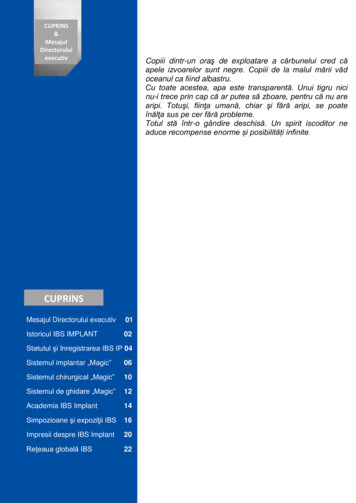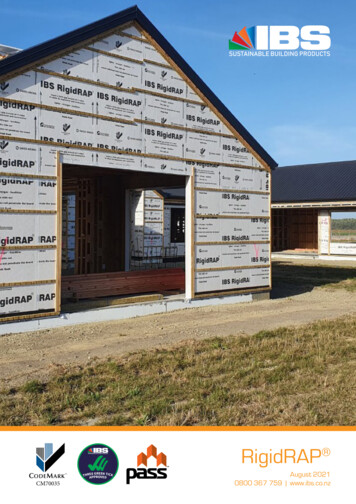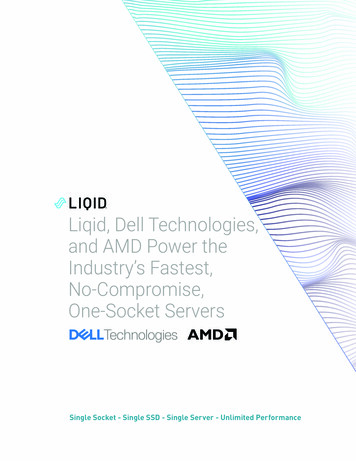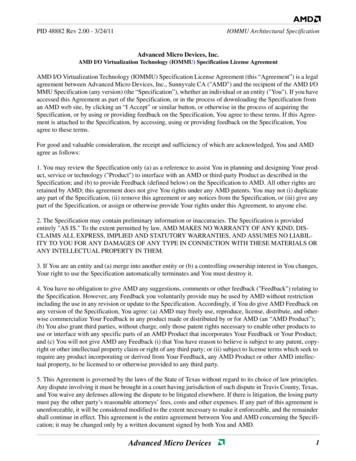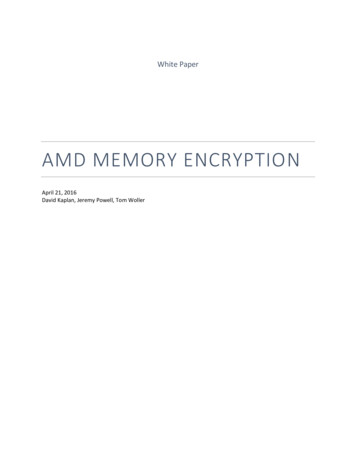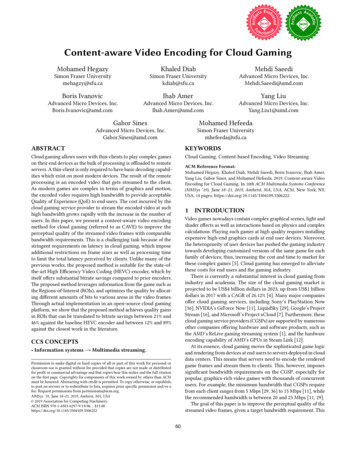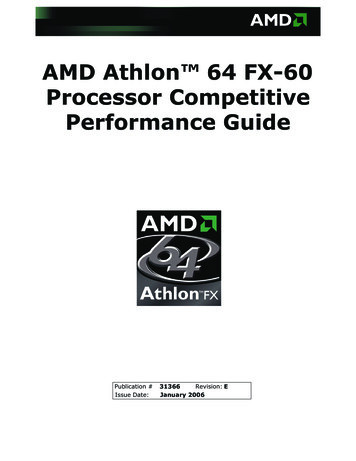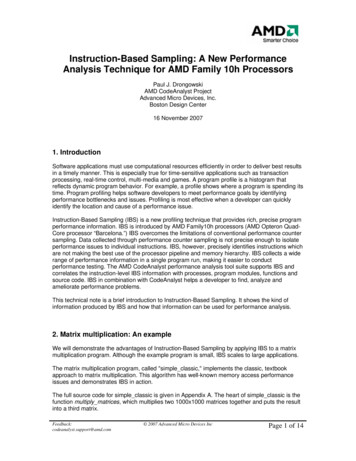
Transcription
Instruction-Based Sampling: A New PerformanceAnalysis Technique for AMD Family 10h ProcessorsPaul J. DrongowskiAMD CodeAnalyst ProjectAdvanced Micro Devices, Inc.Boston Design Center16 November 20071. IntroductionSoftware applications must use computational resources efficiently in order to deliver best resultsin a timely manner. This is especially true for time-sensitive applications such as transactionprocessing, real-time control, multi-media and games. A program profile is a histogram thatreflects dynamic program behavior. For example, a profile shows where a program is spending itstime. Program profiling helps software developers to meet performance goals by identifyingperformance bottlenecks and issues. Profiling is most effective when a developer can quicklyidentify the location and cause of a performance issue.Instruction-Based Sampling (IBS) is a new profiling technique that provides rich, precise programperformance information. IBS is introduced by AMD Family10h processors (AMD Opteron QuadCore processor “Barcelona.”) IBS overcomes the limitations of conventional performance countersampling. Data collected through performance counter sampling is not precise enough to isolateperformance issues to individual instructions. IBS, however, precisely identifies instructions whichare not making the best use of the processor pipeline and memory hierarchy. IBS collects a widerange of performance information in a single program run, making it easier to conductperformance testing. The AMD CodeAnalyst performance analysis tool suite supports IBS andcorrelates the instruction-level IBS information with processes, program modules, functions andsource code. IBS in combination with CodeAnalyst helps a developer to find, analyze andameliorate performance problems.This technical note is a brief introduction to Instruction-Based Sampling. It shows the kind ofinformation produced by IBS and how that information can be used for performance analysis.2. Matrix multiplication: An exampleWe will demonstrate the advantages of Instruction-Based Sampling by applying IBS to a matrixmultiplication program. Although the example program is small, IBS scales to large applications.The matrix multiplication program, called "simple classic," implements the classic, textbookapproach to matrix multiplication. This algorithm has well-known memory access performanceissues and demonstrates IBS in action.The full source code for simple classic is given in Appendix A. The heart of simple classic is thefunction multiply matrices, which multiplies two 1000x1000 matrices together and puts the resultinto a third matrix.Feedback:codeanalyst.support@amd.com 2007 Advanced Micro Devices IncPage 1 of 14
Here is the source code for multiply matrices:void multiply matrices(){// Multiply the two matricesfor (int i 0 ; i ROWS ; i )for (int j 0 ; j COLUMNS ;float sum 0.0 ;for (int k 0 ; k COLUMNSsum sum matrix a[i][k]}matrix r[i][j] sum ;}}}{j ) {; k ) {* matrix b[k][j] ;C and C lay out two-dimensional arrays in row major order; the elements within a row of anarray are arranged sequentially in memory. Sequential memory access is advantageous for goodperformance since data cache locality is improved and hardware-level prefetching can anticipatedata access.Memory access issues in the classic matrix multiplication algorithm arise from non-sequentialaccesses to one of the operand arrays, in this case, matrix b. The fastest changing array index,k, touches a different row of matrix b on each iteration. Since each row of the array is nearly aslarge as a 4K byte memory page, the long stride through memory causes both data cache (DC)misses and data translation lookaside buffer (DTLB) misses.We will first measure the memory access behavior of simple classic using conventionalperformance counter sampling to show its limitations. Then we will measure the memory behaviorof simple classic using IBS and compare the results.3. Performance counter samplingAMD processors provide performance monitoring counters (PMC) to measure importanthardware events that occur during program execution. The word "program" here refers to anyexecuting software component including the operating system, device drivers, and libraries aswell as the application itself. Performance counter sampling uses the PMCs to measure theoccurrence of hardware events like retired instructions, DC misses and DTLB misses. Each PMCis configured to measure a particular event. The number of events that can be measured in asingle performance test is limited by the number of counters. AMD Family 10h Processors havefour PMCs and support performance counter sampling in addition to IBS.Performance counter sampling is a statistical technique that produces information called an“event sample” after the occurrence of a pre-configured number of events. The instructionaddress associated with the event sample is the value of the instruction pointer (IP) at the timethe sample was taken. This is usually the restart address stored on the stack by the samplinginterrupt and is generally not the address of the instruction that caused the triggering event.It is difficult to relate a hardware event to the instruction that triggered it because the restartaddress is not the location after the trigger instruction. Contemporary superscalar machines suchFeedback:codeanalyst.support@amd.com 2007 Advanced Micro Devices IncPage 2 of 14
as AMD quad-core processors use out-of-order execution to exploit instruction-level parallelism.Up to 72 execution operations may be in-flight at any time. Due to operation reordering and inorder instruction retirement, the sampling interrupt triggered by an execution event may besignificantly delayed. The delay is indeterminate and is not fixed. The reporting delay is called“skid.” Due to skid, the reported IP value is only in the general neighborhood of the instructioncausing the event and may be up to 72 instructions away.Inaccuracies due to skid accumulate as the program profile is built up. Events that belong to asingle instruction are attributed to instructions throughout the neighborhood of the culpritinstruction. The ability to isolate a performance issue to any single instruction is lost.To demonstrate the effects of skid, we used PMC sampling to collect a profile for the examplematrix multiplication program. We compiled the simple classic program with optimizations turnedoff in order to keep the generated machine code simple and relatively short. The generated codeis a fairly literal translation of the three nested loops in multiply matrices. We will concentrate onthe innermost loop, since this is the hottest code region in the function.The following table shows the memory access profile of the innermost loop of multiply matrices.(The complete PMC memory access profile for multiply matrices appears in Appendix B.) Theinner loop is implemented by the 16 instructions starting at address 0x401191. The body of theloop reads the array elements from the operand matrices, multiplies the elements together, andadds the product to the running sum. The running sum is stored on the runtime stack at thelocation specified by [ebp-0Ch].Ret instDC accessesedx,dword ptr [ebp-10h]129117637DTLB 91mov00401194addDC misses00401197movdword ptr [ebp-10h],edx0000040119Acmpdword ptr 004011A3moveax,dword ptr dword ptr ord ptr ovesi,dword ptr [ebp-8]0000004011BBflddword ptr [eax edx*4 413FE0h]0000004011C2fmuldword ptr [ecx esi*4 7E48E8h]116511079218004011C9fadddword ptr [ebp-0Ch]33298224154092093004011CCfstpdword ptr 47276From left to right, the events reported are retired instructions, DC accesses, DC misses andaddress translations which missed in both the level 1 and level 2 DTLBs. These latter DTLBmisses have a high performance penalty.The instruction at 0x4011C2 reads an individual element from matrix b and multiplies it with theelement that was read from matrix a. Since access to matrix b is non-sequential, we wouldexpect this instruction to be the source of DC misses and DTLB misses. However, due to skidand other inaccuracies, the DC misses and DTLB misses are spread across several otherFeedback:codeanalyst.support@amd.com 2007 Advanced Micro Devices IncPage 3 of 14
instructions in the code region. Most of the DTLB misses are attributed to the three instructionsafter the culprit and to the jump instruction at address 0x4011A1. This kind of inaccuracy makesprecise attribution of events to the actual culprits impossible in code regions with multipleload/store operations. Lack of precision complicates analysis.All data reported in this note were collected using AMD CodeAnalyst executing on a quad-coreAMD Family 10h processor. Each core provides four PMCs. Without the performance countermultiplexing provided by AMD CodeAnalyst, we would be limited to measuring only four hardwareevents in a single test run and multiple runs would be required to measure additional events. It iseasier and more cost-effective to collect all performance data in a single test run as someperformance experiments are difficult to conduct due to long run-time, platform constraints ornon-trivial user interaction with the application. Performance counter multiplexing makes itpossible to measure many events in one run, but comes at the cost of reduced statisticalaccuracy.4. Instruction-Based SamplingInstruction-Based Sampling is a feature introduced in AMD Family 10h processors. Although IBSis a statistical method, the sampling technique delivers precise event information and eliminatesinaccuracies due to skid.The processor pipeline has two main phases: instruction fetch and instruction execution. Thefetch phase supplies instruction bytes to the decoder. Decoded AMD64 instructions are executedduring the execution phase as discrete operations called “ops.” Since the two phases aredecoupled, IBS provides two forms of sampling: fetch sampling and op sampling. IBS fetchsampling provides information about the fetch phase and IBS op sampling provides informationabout the execution phase.IBS fetch sampling and IBS op sampling use a similar sampling technique. The IBS hardwareselects an operation periodically based on a configurable sampling period. The selectedoperation is tagged and the operation is monitored as it proceeds through the pipeline. Eventscaused by the operation are recorded. When the operation completes, the event information andthe fetch (or instruction) address associated with the operation are reported to the profiler. Thus,events are precisely attributed to the instruction that caused them. IBS does not impose anyoverhead on instruction fetch or execution -- everything runs at full speed.4.1 IBS fetch samplingIBS fetch sampling counts completed fetches and periodically selects a fetch to be tagged andmonitored. Several kinds of information are collected: The fetch addressWhether the fetch completed or abortedWhether the fetch missed in the instruction cache (IC)Whether the fetch missed in the level 1 or level 2 instruction translation lookaside buffer(ITLB)The page size of the address translationThe fetch latency, i.e., cycles from when the fetch was initiated to when the fetch eithercompleted or abortedFeedback:codeanalyst.support@amd.com 2007 Advanced Micro Devices IncPage 4 of 14
This information is collected with every IBS fetch sample and is not restricted by the number ofavailable performance counters.The table below summarizes the IBS fetch samples that were collected for the multiply ed674036395351Completed674036395351Aborted000000IC miss000000Each row of the table shows the number of IBS fetch samples collected for an address (the Allcolumn) and a breakdown of the events reported by the samples. For example, six IBS fetchsamples were taken for the address 0x401180 and all six of those samples were attemptedfetches that completed.Instruction fetch is a speculative activity that anticipates architectural control flow. Fetchoperations may be abandoned due to control flow redirection. Some fetch operations areabandoned at a very early stage before address translation. These killed fetches (the thirdcolumn in the table above) are not useful for analysis and are filtered out by CodeAnalyst. Theremaining fetches (column four) are regarded as true fetch attempts. An attempted fetch mayeither complete and deliver instruction bytes to the decoder (column five), or abort (column six.)Since the matrix multiplication program is so small, it fits entirely in the instruction cache and noIC misses were observed.Feedback:codeanalyst.support@amd.com 2007 Advanced Micro Devices IncPage 5 of 14
The following table shows the IBS fetch results reported by AMD CodeAnalyst for the inner loopof multiply matrices. (The IBS fetch information for the entire function appears in Appendix orted00401191movedx,dword ptr d ptr [ebp-10h],edx000000040119Acmpdword ptr 00004011A3moveax,dword ptr ovecx,dword ptr 5movedx,dword ptr [ebp-10h]00000004011B8movesi,dword ptr [ebp-8]00000004011BBflddword ptr [eax edx*4 413FE0h]39552395339530004011C2fmuldword ptr [ecx esi*4 7E48E8h]000000004011C9fadddword ptr [ebp-0Ch]0000004011CCfstpdword ptr ax,dword ptr ovecx,dword ptr [ebp-8]00000004011DDmovedx,dword ptr [ebp-0Ch]00000004011E0movdword ptr [eax ecx*4 MD Family 10h processors fetch instruction bytes in 32-byte blocks. The address reported byIBS fetch sampling is either the start of a 32-byte fetch block, is the target of a control transfer oris the fall-through of a conditional branch. AMD64 instructions may straddle the start address of afetch block. In these cases, CodeAnalyst associates the IBS fetch sample with the instruction thatstraddles the fetch block.The large number of killed fetch samples at address 0x4011E0 is due to early speculativeprefetch activity. The preceding fetch block contains the jump instruction (address 0x4011CF)that transfers control to the top of the innermost loop. The processor initiates a speculative fetchbefore receiving the control flow redirection back to the top of the innermost loop. These earlyspeculative fetches were killed before instruction translation lookaside buffer access.Feedback:codeanalyst.support@amd.com 2007 Advanced Micro Devices IncPage 6 of 14
4.2 IBS op samplingAMD Family 10h processors execute AMD64 instructions in discrete execution operations (ops.)IBS op sampling counts processor cycles and periodically selects an op to be tagged andmonitored. An IBS op sample is generated when a tagged op retires; a sample is not generatedfor an aborted (flushed) op. The information reported with an IBS op sample includes: The AMD64 instruction address for the opThe tag-to-retire time (cycles from when the op was tagged to when the op retired)The completion-to-retire time (cycles from when the op completed to when the op retired)Whether the op implements AMD64 branch semantics (a "branch op")o If the branch op was mispredictedo If the branch was takeno If the branch was a returno If the return was mispredictedWhether the op was a resync that caused a pipeline flushWhether the op performed a load and/or store operationo If the operation missed in the data cacheo If the operation missed in the level 1 or level 2 DTLBo The page size of the level 1 or level 2 address translationo If the operation caused a misaligned accesso The DC miss latency (in cycles) if the load operation missed in the data cacheo The virtual and physical address of the requested memory locationo If the access was made to local or remote memoryThe event information is extensive and would require a large number of performance counters inorder to collect equivalent data in a single test run (without performance counter multiplexing.)The following table shows a breakdown of the IBS op samples for the inner loop ofmultiply matrices. (A full breakdown for multiply matrices is given in Appendix D.)AddressInstructionAll opsBranchLoad/store00401191movedx,dword ptr 7movdword ptr [ebp-10h],edx325080325080040119Acmpdword ptr 1004011A3moveax,dword ptr 11ACmovecx,dword ptr 4011B5movedx,dword ptr [ebp-10h]129501290004011B8movesi,dword ptr [ebp-8]130201302004011BBflddword ptr [eax edx*4 413FE0h]412704127004011C2fmuldword ptr [ecx esi*4 7E48E8h]409104090004011C9fadddword ptr [ebp-0Ch]421604199004011CCfstpdword ptr 0The third column is the number of IBS op samples taken at each address. The fourth and fifthcolumns show the number IBS op samples that were branch ops and/or load/store ops. The jumpFeedback:codeanalyst.support@amd.com 2007 Advanced Micro Devices IncPage 7 of 14
instructions at 0x4011A1 and 0x4011CF are correctly identified as branches, illustrating theprecision offered by IBS.The conditional jump at address 0x4011a1 is taken when the loop exit condition is true. 3,379 IBSbranch op samples were attributed to this address. Of these samples, only two indicated that thebranch was mispredicted. These statistics indicate that the branch was predicted correctly andthat branch misprediction is not a performance issue. This kind of analysis is not possible withbranch data collected via performance counter sampling since mispredictions or the even thenumber of times a branch is executed cannot be attributed to a specific branch instruction due toaccumulated inaccuracies.The table below shows IBS op data for load and store operations within the inner loop ofmultiply matrices.DTLB L1ML2M0AddressInstructionLoadStoreDC miss0x401191movedx,dword ptr rd ptr [ebp-10h],edx0325082100x40119acmpdword ptr veax,dword ptr movecx,dword ptr 4011b5movedx,dword ptr [ebp-10h]12900110x4011b8movesi,dword ptr [ebp-8]13020000x4011bbflddword ptr [eax edx*4 413FE0h]4127051180x4011c2fmuldword ptr [ecx esi*4 7E48E8h]4090089231410x4011c9fadddword ptr [ebp-0Ch]419812010x4011ccfstpdword ptr [ebp-0Ch]412203910x4011cfjmp0040119133720Unlike the PMC-based profile, the source of data cache and DTLB misses can be accuratelyidentified as the instruction at address 0x4011C2. IBS lets a software developer identifyperformance culprits with pin-point precision.The data cache miss latency for the culprit instruction was 92,465 cycles for the collectedsamples. This yields an average data cache miss latency of 103.66 processor clock cycles. Thelarge latency is due to the DTLB misses and relatively long read accesses to memory as a resultof data cache misses.Feedback:codeanalyst.support@amd.com 2007 Advanced Micro Devices IncPage 8 of 14
5. New opportunities for analysisInstruction-Based Sampling provides rich performance data that lets software developers identifyperformance culprits precisely. This article describes only the basic features of IBS. Otherfeatures offer new opportunities for analysis and optimization: IBS op samples report the address of the memory data item accessed by a load or storeoperation. Coupled with information about local/remote memory access, the address canbe used for “data centric” analysis such as analyzing and optimizing data layout on nonuniform memory access (NUMA) platforms. Precise IBS information can be used to drive profile-directed compiler optimizations. Forexample, a compiler could use precise branch taken/not taken information for codestraightening.For more information about Instruction-Based Sampling, please see the Software OptimizationGuide for Family 10h Processors (Quad-Core) available at AMD Developer Central.http://www.amd.com/us-en/assets/content type/white papers and tech docs/40546.pdfAMD CodeAnalyst is available for download, also at AMD Developer Central:CodeAnalyst for Windows: http://developer.amd.com/cawin.jspCodeAnalyst for Linux: http://developer.amd.com/calinux.jsp6. PostscriptAcknowledgements:Many people contributed to the success of IBS. On the hardware side, I would like to thank BenSander (architect), Ravi Bhargava and Anasua Bhowmik. I would like to thank the entire AMDCodeAnalyst team especially Lei Yu (team leader), Frank Swehosky, Barry Kasindorf and TomEvans.Short bio:Paul Drongowski is an AMD Senior Member of Technical Staff. He is an engineer in the AMDCodeAnalyst team and has worked on profiling tools and performance analysis for the last tenyears. In addition to industrial experience, he has taught computer architecture, softwaredevelopment and VLSI design at Case Western Reserve University, Tufts and md.com 2007 Advanced Micro Devices IncPage 9 of 14
Appendix A: Source code for simple classic.cpp// simple classic.cpp : "Textbook" implementation of matrix multiply////////////Author: Paul J. DrongowskiAddress: Boston Design CenterAdvanced Micro Devices, Inc.Boxborough, MA 01719Date:20 October 2005Copyright (c) 2005-2007 Advanced Micro Devices, Inc.////////////////////The purpose of this program is to demonstrate measurementand analysis of program performance using AMD CodeAnalyst(tm).All engineers are familiar with simple matrix multiplication,so this example should be easy to understand.This implementation of matrix multiplication is a directtranslation of the "classic" textbook formula for matrix multiply.Performance of the classic implementation is affected by aninefficient data access pattern, which we should be able toidentify using CodeAnalyst(TM).#include cstdlib #include cstdio #include ctime static const int ROWS 1000 ;static const int COLUMNS 1000 ;// Number of rows in each matrix// Number of columns in each matrixfloat matrix a[ROWS][COLUMNS] ;float matrix b[ROWS][COLUMNS] ;float matrix r[ROWS][COLUMNS] ;// Left matrix operand// Right matrix operand// Matrix resultFILE *result file ;void initialize matrices(){// Define initial contents of the matricesfor (int i 0 ; i ROWS ; i ) {for (int j 0 ; j COLUMNS ; j ) {matrix a[i][j] (float) rand() / RAND MAX ;matrix b[i][j] (float) rand() / RAND MAX ;matrix r[i][j] 0.0 ;}}}void print result(){// Print the result matrixfor (int i 0 ; i ROWS ; i ) {for (int j 0 ; j COLUMNS ; j ) {fprintf(result file, "%6.4f ", matrix r[i][j]) ;}fprintf(result file, "\n") ;Feedback:codeanalyst.support@amd.com 2007 Advanced Micro Devices IncPage 10 of 14
}}void multiply matrices(){// Multiply the two matricesfor (int i 0 ; i ROWS ; i ) {for (int j 0 ; j COLUMNS ; j ) {float sum 0.0 ;for (int k 0 ; k COLUMNS ; k ) {sum sum matrix a[i][k] * matrix b[k][j] ;}matrix r[i][j] sum ;}}}void print elapsed time(){double elapsed ;double resolution ;// Obtain and display elapsed execution timeelapsed (double) clock() / CLK TCK ;resolution 1.0 / CLK TCK ;fprintf(result file,"Elapsed time: %8.4f sec (%6.4f sec resolution)\n",elapsed, resolution) ;}int main(int argc, char* argv[]){if ((result file fopen("simple classic.txt", "w")) NULL) {fprintf(stderr, "Couldn't open result file\n") ;perror(argv[0]) ;return( EXIT FAILURE ) ;}fprintf(result file, "Simple matrix multiplication\n") ;initialize matrices() ;multiply matrices() ;print elapsed time() ;fclose(result file) ;return( 0 ) ;}Feedback:codeanalyst.support@amd.com 2007 Advanced Micro Devices IncPage 11 of 14
Appendix B: PMC memory access profile for multiply matricesAddress InstructionRet inst DC accesses DC misses DTLB L1M L2M00401140 push ebp0000ebp,esp00401141 mov0000esp,10h00401143 sub000000401146 push esi0000dword ptr [ebp-4],000401147 mov0000004011590040114E jmp0000eax,dword ptr [ebp-4]00401150 mov0000eax,100401153 add0000dword ptr [ebp-4],eax00401156 mov0000dword ptr [ebp-4],100000401159 cmp0000004011EE00401160 jge0000dword ptr [ebp-8],000401166 mov0000004011780040116D jmp0000ecx,dword ptr [ebp-8]0040116F mov0000ecx,100401172 add0200dword ptr [ebp-8],ecx00401175 mov0000dword ptr [ebp-8],100000401178 cmp0000004011E90040117F jge1001dword ptr [ebp-0Ch],000401181 mov0000dword ptr [ebp-10h],000401188 mov00000040119A0040118F jmp2000edx,dword ptr [ebp-10h]00401191 mov12911763781edx,100401194 add133015516291dword ptr [ebp-10h],edx00401197 mov0000dword ptr [ebp-10h],10000040119A cmp0201004011D1004011A1 jge1693135328842eax,dword ptr [ebp-4]004011A3 mov0000004011A6 imul eax,eax,40000000ecx,dword ptr [ebp-10h]004011AC mov219618134542004011AF imul ecx,ecx,40000000edx,dword ptr [ebp-10h]004011B5 mov181815791020esi,dword ptr [ebp-8]004011B8 mov0000dword ptr [eax edx*4 413FE0h]004011BB fld0000004011C2 fmul dword ptr [ecx esi*4 7E48E8h]116511079218004011C9 fadd dword ptr [ebp-0Ch]33298224154092093004011CC fstp dword ptr [ebp-0Ch]1798383634125600401191004011CF jmp3365414647276eax,dword ptr [ebp-4]004011D1 mov0000004011D4 imul eax,eax,40003401ecx,dword ptr [ebp-8]004011DA mov2000edx,dword ptr [ebp-0Ch]004011DD mov0000dword ptr [eax ecx*4 0BB51E8h],edx004011E0 mov00000040116F004011E7 jmp67941000401150004011E9 jmp0000esi004011EE pop0000esp,ebp004011EF mov0000popebp004011F10000004011F2 ret0000Feedback:codeanalyst.support@amd.com 2007 Advanced Micro Devices IncPage 12 of 14
Appendix C: IBS fetch profile for multiply nstructionpush ebpmovebp,espsubesp,10hpush esimovdword ptr [ebp-4],0jmp00401159moveax,dword ptr [ebp-4]addeax,1movdword ptr [ebp-4],eaxcmpdword ptr [ebp-4],1000jge004011EEmovdword ptr [ebp-8],0jmp00401178movecx,dword ptr [ebp-8]addecx,1movdword ptr [ebp-8],ecxcmpdword ptr [ebp-8],1000jge004011E9movdword ptr [ebp-0Ch],0movdword ptr [ebp-10h],0jmp0040119Amovedx,dword ptr [ebp-10h]addedx,1movdword ptr [ebp-10h],edxcmpdword ptr [ebp-10h],1000jge004011D1moveax,dword ptr [ebp-4]imul eax,eax,4000movecx,dword ptr [ebp-10h]imul ecx,ecx,4000movedx,dword ptr [ebp-10h]movesi,dword ptr [ebp-8]flddword ptr [eax edx*4 413FE0h]fmul dword ptr [ecx esi*4 7E48E8h]fadd dword ptr [ebp-0Ch]fstp dword ptr [ebp-0Ch]jmp00401191moveax,dword ptr [ebp-4]imul eax,eax,4000movecx,dword ptr [ebp-8]movedx,dword ptr [ebp-0Ch]movdword ptr [eax ecx*4 ppopebpretFeedback:codeanalyst.support@amd.comAll Killed Attempted Completed 0000000000505500000000000000004020 4019110000000000000000000000000000000 2007 Advanced Micro Devices IncPage 13 of 14
Appendix D: IBS op profile multiply nstructionpush ebpmovebp,espsubesp,10hpush esimovdword ptr [ebp-4],0jmp00401159moveax,dword ptr [ebp-4]addeax,1movdword ptr [ebp-4],eaxcmpdword ptr [ebp-4],1000jge004011EEmovdword ptr [ebp-8],0jmp00401178movecx,dword ptr [ebp-8]addecx,1movdword ptr [ebp-8],ecxcmpdword ptr [ebp-8],1000jge004011E9movdword ptr [ebp-0Ch],0movdword ptr [ebp-10h],0jmp0040119Amovedx,dword ptr [ebp-10h]addedx,1movdword ptr [ebp-10h],edxcmpdword ptr [ebp-10h],1000jge004011D1moveax,dword ptr [ebp-4]imul eax,eax,4000movecx,dword ptr [ebp-10h]imul ecx,ecx,4000movedx,dword ptr [ebp-10h]movesi,dword ptr [ebp-8]flddword ptr [eax edx*4 413FE0h]fmul dword ptr [ecx esi*4 7E48E8h]fadd dword ptr [ebp-0Ch]fstp dword ptr [ebp-0Ch]jmp00401191moveax,dword ptr [ebp-4]imul eax,eax,4000movecx,dword ptr [ebp-8]movedx,dword ptr [ebp-0Ch]movdword ptr [eax ecx*4 ppopebpretFeedback:codeanalyst.support@amd.com 2007 Advanced Micro Devices IncIBS all 0000IBS 0300000IBS 602731012901302412740904199122074030240000000Page 14 of 14
IBS in combination with CodeAnalyst helps a developer to find, analyze and ameliorate performance problems. This technical note is a brief introduction to Instruction-Based Sampling. It shows the kind of information produced by IBS and how that information can be used for performance analysis. 2. Matrix multiplication: An example
